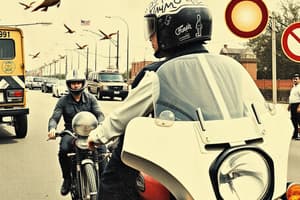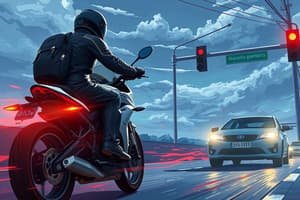Podcast
Questions and Answers
A motorcycle's small size, handling characteristics, and ___________ can cause problems in traffic.
A motorcycle's small size, handling characteristics, and ___________ can cause problems in traffic.
instability
Large blind spots in front, to the sides, and to the rear of a large truck are known as ____________.
Large blind spots in front, to the sides, and to the rear of a large truck are known as ____________.
no zones
Even during daylight hours, it's easier for motorists to identify motorcyclists if cyclists have their __________ on.
Even during daylight hours, it's easier for motorists to identify motorcyclists if cyclists have their __________ on.
headlight
Helmets, gloves, long sleeves, and pants are examples of ______.
Helmets, gloves, long sleeves, and pants are examples of ______.
A two-wheeled vehicle that can be driven by a motor or pedal is known as a ___________.
A two-wheeled vehicle that can be driven by a motor or pedal is known as a ___________.
A truck that has a powerful tractor that pulls a separate trailer is called a ________________.
A truck that has a powerful tractor that pulls a separate trailer is called a ________________.
The_________ provides most of a motorcycle's stopping power.
The_________ provides most of a motorcycle's stopping power.
Some pedestrians________, or disregard traffic rules and signals.
Some pedestrians________, or disregard traffic rules and signals.
To be more visible, motorcyclists should wear___________ clothing when riding at night.
To be more visible, motorcyclists should wear___________ clothing when riding at night.
The most common size tractor-trailer is called the________.
The most common size tractor-trailer is called the________.
A low-powered two-wheeled vehicle that requires no shifting is known as a ___________.
A low-powered two-wheeled vehicle that requires no shifting is known as a ___________.
Golf carts and other vehicles with top speed between 20 and 25 mph are examples of __________.
Golf carts and other vehicles with top speed between 20 and 25 mph are examples of __________.
Wearing a ________ saves lives, reduces traffic noise, and helps prevent fatigue.
Wearing a ________ saves lives, reduces traffic noise, and helps prevent fatigue.
In adverse weather conditions, reduced_______ is far more critical for motorcyclists than for drivers of other types of vehicles.
In adverse weather conditions, reduced_______ is far more critical for motorcyclists than for drivers of other types of vehicles.
Riding in the wheel track of a vehicle ahead on a wet roadway is safe.
Riding in the wheel track of a vehicle ahead on a wet roadway is safe.
Applying the front brake and locking the front wheel is safe.
Applying the front brake and locking the front wheel is safe.
Increasing the following distance is safe.
Increasing the following distance is safe.
Riding on a lane line is safe.
Riding on a lane line is safe.
Crossing railroad tracks at a right angle is safe.
Crossing railroad tracks at a right angle is safe.
Passing at an intersection is safe.
Passing at an intersection is safe.
Riding side-by-side when making a turn is safe.
Riding side-by-side when making a turn is safe.
Keeping headlights on at all times is safe.
Keeping headlights on at all times is safe.
Riding in a driver's blind spot is safe.
Riding in a driver's blind spot is safe.
Riding between lines of moving vehicles is safe.
Riding between lines of moving vehicles is safe.
There is a high incidence of injuries and deaths for motorcyclists because motorcyclists provide little or no protection.
There is a high incidence of injuries and deaths for motorcyclists because motorcyclists provide little or no protection.
It is a good idea for motorists following motorcycles to maintain greater following distances during windy conditions.
It is a good idea for motorists following motorcycles to maintain greater following distances during windy conditions.
Experienced motorcyclists often ride in the left portion of a lane, but it is actually better if they ride in the right portion of a lane.
Experienced motorcyclists often ride in the left portion of a lane, but it is actually better if they ride in the right portion of a lane.
Increasing your following distance between you and a large truck ahead provides additional visibility around the truck.
Increasing your following distance between you and a large truck ahead provides additional visibility around the truck.
Car and truck drivers have more difficulty judging the speed and position of a motorcycle at night than in the day.
Car and truck drivers have more difficulty judging the speed and position of a motorcycle at night than in the day.
A helmet restricts a motorcyclist's vision and should only be worn when riding on an expressway.
A helmet restricts a motorcyclist's vision and should only be worn when riding on an expressway.
The rear brake supplies 70 percent of a motorcycle's braking power.
The rear brake supplies 70 percent of a motorcycle's braking power.
When riding in groups, motorcyclists should always be sure to ride single file.
When riding in groups, motorcyclists should always be sure to ride single file.
The safest and best way to learn to ride a motorcycle is to ask a friend who rides to teach you.
The safest and best way to learn to ride a motorcycle is to ask a friend who rides to teach you.
Most car-motorcycle conflicts occur on rural roadways.
Most car-motorcycle conflicts occur on rural roadways.
Flashcards are hidden until you start studying
Study Notes
Motorcycle Safety and Awareness
- Motorcycles may cause traffic problems due to their small size and instability.
- Motorists should be aware of no zones, large blind spots around trucks that limit visibility.
- Using a headlight during the day improves a motorcyclist's visibility to other drivers.
- Essential protective gear for motorcyclists includes helmets, gloves, long sleeves, and pants.
Types of Two-Wheeled Vehicles
- A moped is a two-wheeled vehicle powered by a motor or pedal.
- A scooter is a low-powered two-wheeled vehicle that requires no shifting.
- Examples of low-speed vehicles include golf carts, typically with a top speed of 20-25 mph.
Motorcycle Components and Operations
- The front brake is crucial, providing most of a motorcycle's stopping power.
- Wearing a helmet not only saves lives but also reduces traffic noise and fatigue.
- Traction is significantly more critical for motorcyclists in adverse weather conditions than for other vehicle drivers.
Riding Practices and Safety
- Riding in the wheel track of a vehicle ahead is considered safe.
- Unsafe actions include locking the front brake, riding on lane lines, and passing at intersections.
- It is safe to increase the following distance and to cross railroad tracks at a right angle.
- Keeping headlights on at all times is a safe practice to enhance visibility.
Visibility and Awareness on the Road
- Riding in a driver's blind spot and between lines of moving vehicles is unsafe.
- The risk of injuries and fatalities for motorcyclists is high due to lack of protection.
- Motorists should maintain greater following distances during windy conditions for accuracy.
Misconceptions in Motorcycle Training and Safety
- Many common beliefs about motorcycling are incorrect, such as thinking experienced riders should stay in the left portion of the lane.
- A helmet does not restrict vision and should be worn at all times, not just on expressways.
- Learning to ride from a friend is not the safest way; formal training is recommended.
- Most car-motorcycle conflicts occur in urban areas, contrary to the belief that rural roadways have higher incidents.
Brake Usage and Group Riding
- The statement that the rear brake supplies a large portion of braking power is incorrect; it actually contributes less than the front brake.
- Members of a group should not always ride single file; this belief is also incorrect.
Studying That Suits You
Use AI to generate personalized quizzes and flashcards to suit your learning preferences.




